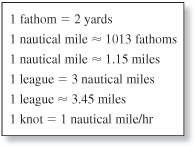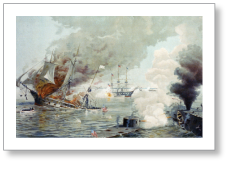-
During the U.S. Civil War, the Confederate ironclad CSS Virginia clashed with the Union ironclad USS Monitor in the Battle of Hampton Roads. The speed of the Monitor was about 9 miles per hour and the speed of the Virginia was about 6 knots. Which ship was faster?


-
To determine which ironclad was faster, convert the speeds to the same units.

The speed of the Virginia was 6 knots. So, the Monitor was faster.
Comments (0)These comments are not screened before publication. Constructive debate about the information on this page is welcome, but personal attacks are not. Please do not post comments that are commercial in nature or that violate copyright. Comments that we regard as obscene, defamatory, or intended to incite violence will be removed. If you find a comment offensive, you may flag it.
When posting a comment, you agree to our Terms of Use.Showing 0 commentsSubscribe by email Subscribe by RSSThere are no comments. -
-
The phrase "deep six" means to throw something away. It was originally used by boaters to mean 6 fathoms. Convert this depth to feet.

These comments are not screened before publication. Constructive debate about the information on this page is welcome, but personal attacks are not. Please do not post comments that are commercial in nature or that violate copyright. Comments that we regard as obscene, defamatory, or intended to incite violence will be removed. If you find a comment offensive, you may flag it.
When posting a comment, you agree to our Terms of Use. -
Territorial waters around the United States used to be defined by the reach of a cannon ball fired from shore, or a "cannon shot." One cannon shot was defined as 3 nautical miles.
- Convert 1 cannon shot to miles.
- Compare this definition of territorial waters to the modern definition.

-
-
You can use unit analysis to convert 1 cannon shot to miles.

- According to the United Nations Convention on the Law of the Sea (1982), territorial waters are a strip of coastal waters no more than 12 nautical miles from a determined baseline. This baseline is defined as the mean low-water mark. Territorial waters include the airspace above as well as the seabed below.
-
These comments are not screened before publication. Constructive debate about the information on this page is welcome, but personal attacks are not. Please do not post comments that are commercial in nature or that violate copyright. Comments that we regard as obscene, defamatory, or intended to incite violence will be removed. If you find a comment offensive, you may flag it.
When posting a comment, you agree to our Terms of Use. -
Jules Verne wrote a famous novel called 20,000 Leagues Under the Sea.
- Convert 20,000 leagues to miles.
- At its deepest point, the ocean is about 7 miles deep. What do you think the title of Verne's novel means? Explain your reasoning.

These comments are not screened before publication. Constructive debate about the information on this page is welcome, but personal attacks are not. Please do not post comments that are commercial in nature or that violate copyright. Comments that we regard as obscene, defamatory, or intended to incite violence will be removed. If you find a comment offensive, you may flag it.
When posting a comment, you agree to our Terms of Use. -
Below is an excerpt from William Shakespeare's The Tempest.
Full fathom five thy father lies;
Of his bones are coral made;
Those are pearls that were his eyes:
Nothing of him that doth fade
But doth suffer a sea-change
Into something rich and strange.Shakespeare writes that the man lies 5 fathoms deep. Convert this depth to feet.

-
Use unit analysis to convert 5 fathoms to feet.

So, the man's body lies 30 feet deep.

These comments are not screened before publication. Constructive debate about the information on this page is welcome, but personal attacks are not. Please do not post comments that are commercial in nature or that violate copyright. Comments that we regard as obscene, defamatory, or intended to incite violence will be removed. If you find a comment offensive, you may flag it.
When posting a comment, you agree to our Terms of Use. -
-
Mark Twain was the pen name of Samuel Clemens, who spent several years as a steamboat pilot. He chose the name because the leadsman on a steamboat would call out "mark twain" to indicate that the water depth was 12 feet and safe for the boat to pass. Convert this depth to fathoms.

These comments are not screened before publication. Constructive debate about the information on this page is welcome, but personal attacks are not. Please do not post comments that are commercial in nature or that violate copyright. Comments that we regard as obscene, defamatory, or intended to incite violence will be removed. If you find a comment offensive, you may flag it.
When posting a comment, you agree to our Terms of Use.





